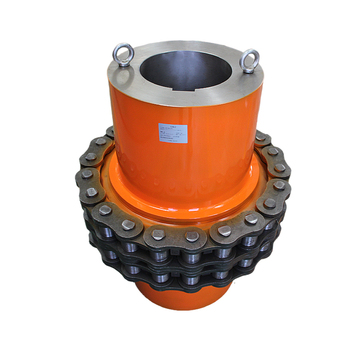What are the advantages and disadvantages of chain couplings? This standard is applicable to chain couplings that
connect two concentric shafts, transmit nominal torque 40~25000N.m, rotate speed no more than 4500r/min, have the
ability to compensate for a small amount of axis displacement, and have slight Buffering capacity.
Chain couplings have the following advantages:
(1) Simple structure, easy assembly and disassembly; low cost; simple manufacturing and maintenance; when installing, just
wrap the chain around the sprocket and insert the connecting link pin and it is complete; when disassembling, just pull out
the connecting link The pin shaft can be separated without axial movement of the connected shaft. And because of its small
size and light weight, it consumes less material and requires less machining, and the chain is also a very cheap standard part.
There are no special requirements for the components of the chain coupling. Except for standard parts, they are all easily
achieved by the general mechanical manufacturing level. Maintenance requirements are low, requiring only regular greasing.
During maintenance, it is also easy to replace the chain.
(2) Compact size and light weight: The force-bearing part of the chain coupling is far away from the rotation axis, and there
are more teeth meshing at the same time to share the load, making the load on each tooth smaller. In addition, compared with
gears, chains The wheel meshing point is at a lower position and the gear teeth are not easy to bend and break. Therefore, it
can be made small in size. Compared with gear couplings, it is much more compact under the same working conditions For
example, a 15/3-ton bridge crane originally used a gear coupling with an outer diameter of φ220 and replaced it with a chain
coupling with an outer diameter of φ150. The weight can be reduced by more than 2/3. Compared with the elastic ring pin
coupling, its technical and economic benefits are more obvious. For example, on the oil supply pump of a 400-ton hydraulic
press, the power P=7.5kW, the rotation speed n=1450r/min, the original elastic ring pin coupling The outer diameter of the
shaft is φ130 and the weight is 6.5kg; if the chain coupling is used, the outer diameter is only φ60 and the weight is 1.1kg.
(3) It has certain compensability; there are gaps between the components in the chain hinge, between the rollers and the
tooth grooves, between the inside of the inner link plate and the end face of the sprocket, and the chain will produce a certain
elastic deformation after being stressed, so the linkage The shaft has a small amount of compensation capability.

(4) Reliable operation, long service life, and high efficiency; the chain itself has high strength and high wear resistance. When
the sprocket is made of medium carbon steel and high-frequency quenching, the coupling can be quite strong and reliable.
When correctly designed, installed, and Under lubricated use conditions, the life of the chain coupling can even be as long as
20,000 hours. Within the allowable installation error range, under good lubrication conditions, its transmission efficiency is
close to 100%.
(5) It has strong adaptability to the environment; it can adapt to a wide range of shaft diameters; it has a certain buffering and
vibration-absorbing effect; it can be applied under various working conditions of high temperature, humidity, dust, oil and
other corrosive atmospheres. Compared with other couplings, because the force transmission part is close to the outer edge
of the coupling, it has a wider range of applicable shaft diameters under the same outer diameter and is more convenient to
select. Because the chain has a certain elasticity, it can play a buffering and vibration-absorbing role.
The disadvantages of chain couplings are:
(1) At high speeds, the centrifugal force of the chain is large and the wear between components is accelerated, making it easy
to overheat, which limits the allowable limit speed.
(2) Under conditions of severe impact load or torsional vibration, the buffering and vibration absorption capacity of this
coupling is insufficient. At the same time, impact load can easily destroy the interference connection between roller chain
elements, causing the chain to fall apart.
(3) Not suitable for transmitting axial force
To sum up, it can be considered that as long as the axis deviation is too large, the working speed is too high, the working
speed is not working under severe impact loads, and it is not used to transmit axial force, the use of chain couplings will bring
obvious technical and economic benefits.
Contact: Spark Wang
Phone: 86-19932127135
E-mail: admin@rongxingcoupling.com
Add: North side of Planning 4th Road, Southern Industrial New Town, Jizhou District, Hengshui City, Hebei Province, China